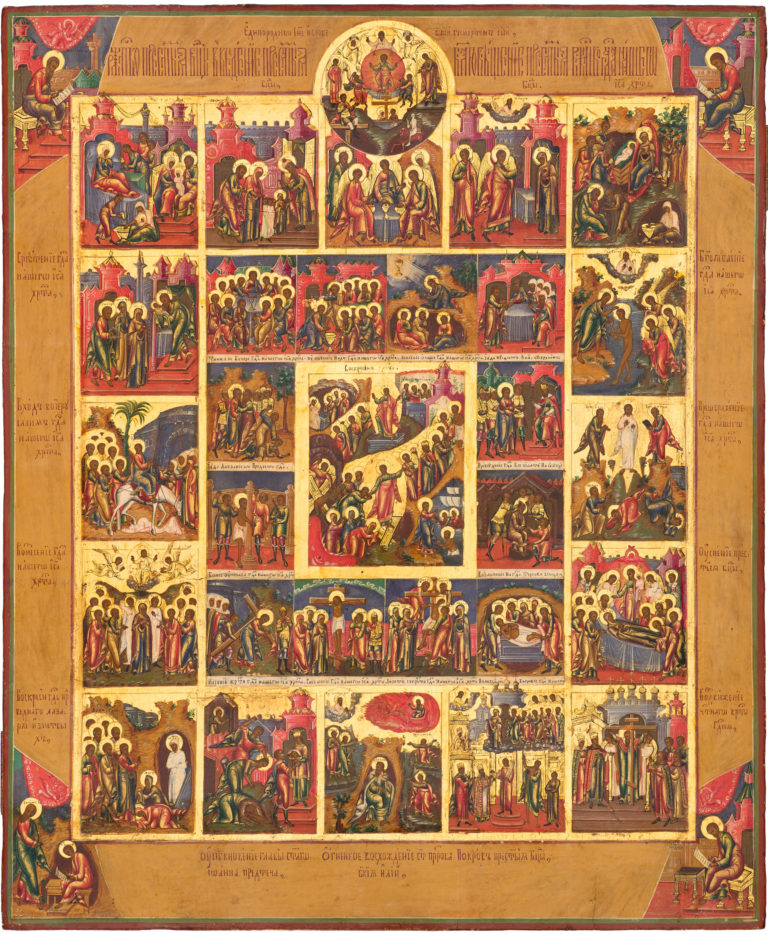The Resurrection—the Descent into Hell, with the Monogenes, the Passions of Christ, Church Feasts in 28 Border Scenes, and the Four Evangelists
Antique Russian icon. Third quarter of the 19th century. Palekh.
Size: 53 х 44 х 2.8 cm
Wood (two panels), two incut, profiled support boards, absence of the incut centerpiece, underlying layer of gesso is not visible, gesso, tempera.
The author’s paintwork is in an overall good state with only small fallouts and chafing of paint.
Contact us

The Resurrection—the Descent into Hell, with the Monogenes, the Passions of Christ, Church Feasts in 28 Border Scenes, and the Four Evangelists
Diagram of the border scenes:
The Feast cycle:
- The Nativity of the Mother of God;
- The Entrance of the Mother of God into the Temple;
- The Old Testament Trinity;
- The Annunciation;
- The Nativity of Christ;
- Candlemas (The Meeting of Christ in the Temple);
- The Theophany (The Baptism of Christ);
- The Entrance into Jerusalem;
- The Transfiguration;
- The Ascension;
- The Dormition of the Mother of God;
- The Raising of Lazarus;
- The Beheading of John the Baptist;
- The Fiery Ascent of the Prophet Elias;
- The Pokrov (Feast of the Protective veil of the Mother of God);
- The Elevation of the Holy Cross.
The Passion cycle:
- The Last Supper;
- The Washing of the Feet;
- The Prayer in Gethsemane;
- Judas accepts the 30 pieces of silver;
- The Betrayal of Judas and the Arrest of Christ;
- Christ is brought before Pilate;
- The Flagellation of Christ;
- The Crown of Thorns;
- The Carrying of the Cross;
- The Crucifixion;
- The Taking Down from the Cross;
- The Entombment of Christ.
- The Monogenis;
- The Evangelist Matthew;
- The Evangelist Mark;
- The Evangelist John the Theologian;
- The Evangelist Luke.
Hand-painted Orthodox icons with a complex composition that includes the Resurrection – the Harrowing of Hades and the main Church feasts became widespread in the 19th century. The centerpiece of the given antique Russian icon bears the detailed variation of the Resurrection – the Harrowing of Hades, popular in the later-period Russian icon paintings. Besides the depictions of Christ – rising from the tomb and leading Adam out of the pits of hell – the religious icon composition includes two processions: the angels descending to the Gates of Hell and the Pious led by the Good Thief and marching up to the Kingdom of Heaven. In the corners of the religious icon centerpiece, we see two other Gospel scenes – “The Revelation of the Angel to the Myrrh-bearing women” and “The Revelation of Christ to the Apostles on the Sea of Galilee.” In the earlier cycles of such Orthodox Christian icons made in the 16th and 17th centuries, these scenes, along with the Feasts, would be included into the Passion iconography or religious icon paintings dedicated to the Revelations of Christ after the Resurrections. In this case, the Passion cycle forms the inner frame of border scenes, twelve in number. The selection of Passion scenes included in this antique Russian icon is traditional for this iconographic variation. The only unique feature is the scene of Judas accepting the 30 pieces of silver (border scene 20), not often seen in such cycles.
The Feast cycle – containing 16 border scenes and forming the exterior frame – begins with the Nativity of the Mother of God, which inaugurates the yearly liturgical cycle, and ends with the Elevation of the Holy Cross. The inclusion of the “Raising of Lazarus,” “The Fiery Ascent of the Prophet Elias,” and the “Beheading of John the Baptist” is highly symbolic. John the Baptist is the first man who openly proclaimed the coming of Christ and the Messiah’s role in the Salvation of Mankind, while the other two scenes are seen as forerunners of the Resurrection. In the upmost tier, we see the Old Testament Trinity and the “Monogenis” (The Only Begotten Son) religious icon paintings, which are symbols of the Reunification of the Three Persons of the Trinity and the sign of Mankind’s return to the Kingdom of Heaven.